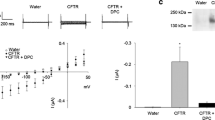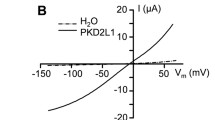Abstract
Mammalian glycosylated rhesus (Rh) proteins include the erythroid RhAG and the nonerythroid RhBG and RhCG. RhBG and RhCG are expressed in multiple tissues, including hepatocytes and the collecting duct (CD) of the kidney. Here, we expressed human RhAG, RhBG and RhCG in Xenopus oocytes (vs. H2O-injected control oocytes) and used microelectrodes to monitor the maximum transient change in surface pH (ΔpHS) caused by exposing the same oocyte to 5 % CO2/33 mM HCO3 − (an increase) or 0.5 mM NH3/NH4 + (a decrease). Subtracting the respective values for day-matched, H2O-injected control oocytes yielded channel-specific values (*). \(({\Updelta {\text{pH}}_{\text{S}}^{*} })_{{{\text{CO}}_{ 2} }}\) and \(({ - \Updelta {\text{pH}}_{\text{S}}^{*} })_{{{\text{NH}}_{ 3} }}\) were each significantly >0 for all channels, indicating that RhBG and RhCG—like RhAG—can carry CO2 and NH3. We also investigated the role of a conserved aspartate residue, which was reported to inhibit NH3 transport. However, surface biotinylation experiments indicate the mutants RhBGD178N and RhCGD177N have at most a very low abundance in the oocyte plasma membrane. We demonstrate for the first time that RhBG and RhCG—like RhAG—have significant CO2 permeability, and we confirm that RhAG, RhBG and RhCG all have significant NH3 permeability. However, as evidenced by \(({\Updelta {\text{pH}}_{\text{S}}^{*} })_{{{\text{CO}}_{ 2} }} /({ - \Updelta {\text{pH}}_{\text{S}}^{*} })_{{{\text{NH}}_{ 3} }}\) values, we could not distinguish among the CO2/NH3 permeability ratios for RhAG, RhBG and RhCG. Finally, we propose a mechanism whereby RhBG and RhCG contribute to acid secretion in the CD by enhancing the transport of not only NH3 but also CO2 across the membranes of CD cells.








Similar content being viewed by others
References
Attmane-Elakeb A, Amlal H, Bichara M (2001) Ammonium carriers in medullary thick ascending limb. Am J Physiol Renal Physiol 280:F1–F9
Bakouh N, Benjelloun F, Cherif-Zahar B, Planelles G (2006) The challenge of understanding ammonium homeostasis and the role of the Rh glycoproteins. Transfus Clin Biol 13:139–146
Bishop JM, Verlander JW, Lee H-W et al (2010) Role of the rhesus glycoprotein, Rh B glycoprotein, in renal ammonia excretion. Am J Physiol Renal Physiol 299:F1065–F1077
Biver S, Belge H, Bourgeois S et al (2008) A role for rhesus factor Rhcg in renal ammonium excretion and male fertility. Nature 456:339–343
Boron WF, Boulpaep EL (1983) Intracellular pH regulation in the renal proximal tubule of the salamander. Basolateral HCO3 − transport. J Gen Physiol 81:53–94
Brion LP, Schwartz JH, Zavilowitz BJ, Schwartz GJ (1988) Micro-method for the measurement of carbonic anhydrase activity in cellular homogenates. Anal Biochem 175:289–297
Brown ACN, Hallouane D, Mawby WJ et al (2009) RhCG is the major putative ammonia transporter expressed in the human kidney, and RhBG is not expressed at detectable levels. Am J Physiol Renal Physiol 296:F1279–F1290
Bruce LJ, Guizouarn H, Burton NM et al (2009) The monovalent cation leak in overhydrated stomatocytic red blood cells results from amino acid substitutions in the Rh-associated glycoprotein. Blood 113:1350–1357
Cooper GJ, Boron WF (1998) Effect of pCMBS on CO2 permeability of Xenopus oocytes expressing aquaporin 1 or its C189S mutant. Am J Physiol Cell Physiol 275:C1481–C1486
Eladari D, Cheval L, Quentin F et al (2002) Expression of RhCG, a new putative NH3/NH4 + transporter, along the rat nephron. J Am Soc Nephrol 13:1999–2008
Endeward V, Musa-Aziz R, Cooper GJ et al (2006) Evidence that aquaporin 1 is a major pathway for CO2 transport across the human erythrocyte membrane. FASEB J 20:1974–1981
Endeward V, Cartron J-P, Ripoche P, Gros G (2008) RhAG protein of the rhesus complex is a CO2 channel in the human red cell membrane. FASEB J 22:64–73
Geyer RR, Musa-Aziz R, Enkavi G et al (2013a) Movement of NH3 through the human urea transporter B (UT-B): a new gas channel. Am J Physiol Renal Physiol. doi:10.1152/ajprenal.00609.2012
Geyer RR, Musa-Aziz R, Qin X, Boron WF (2013b) Relative CO2/NH3 selectivities of mammalian aquaporins 0–9. Am J Physiol Cell Physiol. doi:10.1152/ajpcell.00033.2013
Giebisch G, Windhager EE (2009) Urine concentration and dilution. In: Boron WF, Boulpaep EL (eds) Medical physiology: a cellular and molecular approach, 2nd edn. Elsevier, Philadelphia, pp 835–850
Gruswitz F, Chaudhary S, Ho JD et al (2010) Function of human Rh based on structure of RhCG at 2.1 Å. Proc Natl Acad Sci USA 107:9638–9643
Han K-H, Croker BP, Clapp WL et al (2006) Expression of the ammonia transporter, Rh C glycoprotein, in normal and neoplastic human kidney. J Am Soc Nephrol 17:2670–2679
Han K-H, Mekala K, Babida V et al (2009) Expression of the gas-transporting proteins, Rh B glycoprotein and Rh C glycoprotein, in the murine lung. Am J Physiol Lung Cell Mol Physiol 297:L153–L163
Han K-H, Lee H-W, Handlogten ME et al (2013) Expression of the ammonia transporter family member, Rh B glycoprotein, in the human kidney. Am J Physiol Renal Physiol 304:F972–F981
Herrera M, Garvin JL (2007) Novel role of AQP-1 in NO-dependent vasorelaxation. Am J Physiol Renal Physiol 292:F1443–F1451
Herrera M, Hong NJ, Garvin JL (2006) Aquaporin-1 transports NO across cell membranes. Hypertension 48:157–164
Javelle A, Severi E, Thornton J, Merrick M (2004) Ammonium sensing in Escherichia coli: role of the ammonium transporter AmtB and AmtB-GlnK complex formation. J Biol Chem 279:8530–8538
Kaldenhoff R (2012) Mechanisms underlying CO2 diffusion in leaves. Curr Opin Plant Biol 15:276–281
Kaldenhoff R, Fischer M (2006) Aquaporins in plants. Acta Physiol (Oxf) 187:169–176
Kim H-Y, Verlander JW, Bishop JM et al (2009) Basolateral expression of the ammonia transporter family member Rh C glycoprotein in the mouse kidney. Am J Physiol Renal Physiol 296:F543–F555
Lee H-W, Verlander JW, Bishop JM et al (2009) Collecting duct-specific Rh C glycoprotein deletion alters basal and acidosis-stimulated renal ammonia excretion. Am J Physiol Renal Physiol 296:F1364–F1375
Lee H-W, Verlander JW, Bishop JM et al (2010) Effect of intercalated cell–specific Rh C glycoprotein deletion on basal and metabolic acidosis–stimulated renal ammonia excretion. Am J Physiol Renal Physiol 299:F369–F379
Lopez C, Métral S, Eladari D et al (2005) The ammonium transporter RhBG: requirement of a tyrosine-based signal and ankyrin-G for basolateral targeting and membrane anchorage in polarized kidney epithelial cells. J Biol Chem 280:8221–8228
Ludewig U (2004) Electroneutral ammonium transport by basolateral rhesus B glycoprotein. J Physiol (Lond) 559:751–759
Mak D-OD, Dang B, Weiner ID et al (2006) Characterization of ammonia transport by the kidney Rh glycoproteins RhBG and RhCG. Am J Physiol Renal Physiol 290:F297–F305
Marini AM, Boeckstaens M, Benjelloun F et al (2006) Structural involvement in substrate recognition of an essential aspartate residue conserved in Mep/Amt and Rh-type ammonium transporters. Curr Genet 49:364–374
Musa-Aziz R, Chen L-M, Pelletier MF, Boron WF (2009a) Relative CO2/NH3 selectivities of AQP1, AQP4, AQP5, AmtB, and RhAG. Proc Natl Acad Sci USA 106:5406–5411
Musa-Aziz R, Jiang L, Chen L-M et al (2009b) Concentration-dependent effects on intracellular and surface pH of exposing Xenopus oocytes to solutions containing NH3/NH4 +. J Membr Biol 228:15–31
Musa-Aziz R, Boron WF, Parker MD (2010) Using fluorometry and ion-sensitive microelectrodes to study the functional expression of heterologously-expressed ion channels and transporters in Xenopus oocytes. Methods 51:134–145
Nagami GT (1988) Luminal secretion of ammonia in the mouse proximal tubule perfused in vitro. J Clin Invest 81:159–164
Nakhoul NL, Davis BA, Romero MF, Boron WF (1998) Effect of expressing the water channel aquaporin-1 on the CO2 permeability of Xenopus oocytes. Am J Physiol Cell Physiol 274:C543–C548
Nakhoul NL, Hering-Smith KS, Abdulnour-Nakhoul SM, Hamm LL (2001) Transport of NH3/NH4 + in oocytes expressing aquaporin-1. Am J Physiol Renal Physiol 281:F255–F263
Quentin F, Eladari D, Cheval L et al (2003) RhBG and RhCG, the putative ammonia transporters, are expressed in the same cells in the distal nephron. J Am Soc Nephrol 14:545–554
Ripoche P, Bertrand O, Gane P et al (2004) Human rhesus-associated glycoprotein mediates facilitated transport of NH3 into red blood cells. Proc Natl Acad Sci USA 101:17222–17227
Ripoche P, Goossens D, Devuyst O et al (2006) Role of RhAG and AQP1 in NH3 and CO2 gas transport in red cell ghosts: a stopped-flow analysis. Transfus Clin Biol 13:117–122
Romero MF (2005) Molecular pathophysiology of SLC4 bicarbonate transporters. Curr Opin Nephrol Hypertens 14:495–501
Romero MF, Hediger MA, Boulpaep EL, Boron WF (1997) Expression cloning and characterization of a renal electrogenic Na+CO3 − cotransporter. Nature 387:409–413
Seshadri RM, Klein JD, Kozlowski S et al (2006) Renal expression of the ammonia transporters, Rhbg and Rhcg, in response to chronic metabolic acidosis. Am J Physiol Renal Physiol 290:F397–F408
Singh SK, Binder HJ, Geibel JP, Boron WF (1995) An apical permeability barrier to NH3/NH4 + in isolated, perfused colonic crypts. Proc Natl Acad Sci USA 92:11573–11577
Somersalo E, Occhipinti R, Boron WF, Calvetti D (2012) A reaction-diffusion model of CO2 influx into an oocyte. J Theor Biol 309:185–203
Toye AM, Williamson RC, Khanfar M et al (2008) Band 3 Courcouronnes (Ser667Phe): a trafficking mutant differentially rescued by wild-type band 3 and glycophorin A. Blood 111:5380–5389
Uehlein N, Lovisolo C, Siefritz F, Kaldenhoff R (2003) The tobacco aquaporin NtAQP1 is a membrane CO2 pore with physiological functions. Nature 425:734–737
Uehlein N, Sperling H, Heckwolf M, Kaldenhoff R (2012) The Arabidopsis aquaporin PIP1;2 rules cellular CO2 uptake. Plant Cell Environ 35:1077–1083
Verlander JW, Miller RT, Frank AE et al (2003) Localization of the ammonium transporter proteins RhBG and RhCG in mouse kidney. Am J Physiol Renal Physiol 284:F323–F337
Wagner CA, Devuyst O, Bourgeois S, Mohebbi N (2009) Regulated acid-base transport in the collecting duct. Pflugers Arch 458:137–156
Wagner CA, Devuyst O, Belge H et al (2011) The rhesus protein RhCG: a new perspective in ammonium transport and distal urinary acidification. Kidney Int 79:154–161
Waisbren SJ, Geibel JP, Modlin IM, Boron WF (1994) Unusual permeability properties of gastric gland cells. Nature 368:332–335
Weiner ID, Verlander JW (2010) Molecular physiology of the Rh ammonia transport proteins. Curr Opin Nephrol Hypertens 19:471–477
Weiner ID, Verlander JW (2011) Role of NH3/NH4 + transporters in renal acid-base transport. Am J Physiol Renal Physiol 300:F11–F23
Zidi-Yahiaoui N, Mouro-Chanteloup I, D’Ambrosio A-M et al (2005) Human rhesus B and rhesus C glycoproteins: properties of facilitated ammonium transport in recombinant kidney cells. Biochem J 391:33–40
Acknowledgments
We thank Dale Huffman for computer support, Dr. Alice Brown (University of Bristol) for plasmid cloning and Dr. Nancy Amaral Rebouças (University of São Paulo) and Dr. Seong-Ki Lee (Case Western Reserve University) for helpful discussions. R. R. G. was supported by postdoctoral fellowship N00014-09-1-0246 from the Office of Naval Research. R. M.-A. was supported by Fundação de Amparo a Pesquisa do Estado de São Paulo (FAPESP, 08/128663). This work was supported by Office of Naval Research grant N00014-11-1-0889 and NIH grant DK81567 to W. F. B. A. M. T. received funding from Kidney Research UK and NHS Blood and Transplant R&D.
Author information
Authors and Affiliations
Corresponding author
Rights and permissions
About this article
Cite this article
Geyer, R.R., Parker, M.D., Toye, A.M. et al. Relative CO2/NH3 Permeabilities of Human RhAG, RhBG and RhCG. J Membrane Biol 246, 915–926 (2013). https://doi.org/10.1007/s00232-013-9593-0
Received:
Accepted:
Published:
Issue Date:
DOI: https://doi.org/10.1007/s00232-013-9593-0




